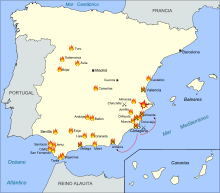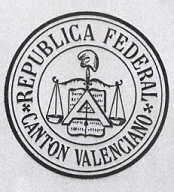
Back ثورة الكانتونات Arabic Kantona Revolucio Esperanto Rebelión cantonal Spanish Kantoien matxinada Basque Révolution cantonale French Powstanie kantonalistów Polish Revolução Cantonal Portuguese Кантональное восстание Russian Kanton Devrimi Turkish
| Cantonal rebellion | |||||||
|---|---|---|---|---|---|---|---|
 | |||||||
| |||||||
| Belligerents | |||||||
|
|
| ||||||
| Commanders and leaders | |||||||
|
|
| ||||||
| Part of a series on |
| Libertarian socialism |
|---|
 |

The Cantonal rebellion was a cantonalist insurrection that took place during the First Spanish Republic between July 1873 and January 1874. Its protagonists were the "intransigent" federal Republicans, who wanted to establish immediately the Federal Republic from the bottom-up without waiting for the Constituent Cortes to draft and approve the new Federal Constitution, as defended by the president of the Executive Power of the Republic Francisco Pi y Margall, a Proudhonian Mutualist supported by the "centrist" and "moderate" sectors of the Federal Democratic Republican Party.[1]
Pi y Margall was the principal translator of Proudhon's works, according to George Woodcock "These translations were to have a profound and lasting effect on the development of Spanish anarchism after 1870, but before that time Proudhonian ideas, as interpreted by Pi, already provided much of the inspiration for the federalist movement which sprang up in the early 1860s."[2] According to the Encyclopædia Britannica "During the Spanish revolution of 1873, Pi y Margall attempted to establish a decentralized, or “cantonalist," political system on Proudhonian lines."[3]
The rebellion began on 12 July 1873 with the Canton of Cartagena[4][5] – although three days earlier the Petroleum Revolution had broken out in Alcoy at the initiative of the Spanish section of the International Workers Association (AIT) – spreading in the following days through the regions of Valencia, Murcia and Andalusia. In these areas, cantons were formed, whose federation would constitute the base of the Spanish Federal Republic. The political theory on which the cantonal movement was based was the "pactist" federalism of Francisco Pi y Margall against whose government the "intransigent" federal republicans (paradoxically) rose up against. When the policy of the Pi y Margall government failed to combine persuasion with repression to end the insurrection, the government that replaced him chaired by the "moderate" Nicolás Salmerón did not hesitate to employ the army led by generals Arsenio Martínez Campos and Manuel Pavia to crush the rebellion, a policy that accentuated the next government of the also "moderate" Emilio Castelar, who, after suspending the sessions of the Cortes, began the siege of Cartagena, the last stronghold of the rebellion. Cartagena would not fall into the hands government until 12 January, a week after the coup of Pavia that ended the federal Republic giving way to the dictatorship of Serrano.
Although the cantonal rebellion was considered a "separatist" movement by the Government of the Republic, the current historiography highlights that the rebellion only sought to reform the structure of the state, without ever wanting to break the unity of Spain.[6]
- ^ George Woodcock. Anarchism: a history of libertarian movements. Pg. 357
- ^ George Woodcock. Anarchism: a history of libertarian movements. Pg. 357
- ^ "Anarchism" at the Encyclopædia Britannica online.
- ^ El Imparcial. Madrid. 26 July 1873, p. 3
- ^ El Imparcial. Madrid. 22 de diciembre de 1873, p. 2
- ^ Piqueras 2014, pp. 362–363"the insurectional movement [was] promoted by federal sectors that had decided to impose what they did not trust the government to give them ", a federation through prior recognition of the full sovereignty of the States so that they agreed the pact ... The cantons were the name that was given to the States that by means of the pact had to be federated ... »
© MMXXIII Rich X Search. We shall prevail. All rights reserved. Rich X Search